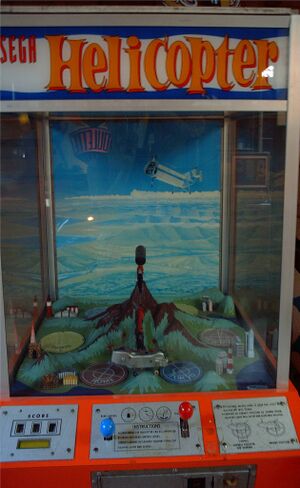Difference between revisions of "Helicopter"
From Sega Retro
Scarred Sun (talk | contribs) |
m (spelling/grammar/fixes, typos fixed: Amusment → Amusement) |
||
| Line 1: | Line 1: | ||
| − | [[File: | + | [[File:Helicopter machine1.jpg|right|frameless]] |
| − | '''''Helicopter''''' is a July 1968 10-cent electro-mechanical arcade game similar to Midway's helicopter game ''Whirly Bird'' (1969) and | + | '''''Helicopter''''' is a July 1968 10-cent electro-mechanical arcade game similar to Midway's helicopter game ''Whirly Bird'' (1969) and Amusement Engineering's ''Helicopter Trainer'' (1968). Players fly a helicopter around circle. The helicopter is attached to a rod that pivots on top of a center pylon and a counter weight helps lift the helicopter. Player controls the helicopter's pitch and speed. The object of the game is to fly the helicopter so it touch one of seven stationary pins (located around the edges of the helicopter's circle of rotation) with the helicopter's two pring "whiskers". The stationary pin to touch is identified by a light. After touching one stationary pin, another stationary pin is lit. When the correct pin is hit, points are scored. There is a set amount of time per game. The more targets hit, the higher the score. Sega Helicopter uses an 8-track tape for background sound for the helicopter engine and rotor sound effects. The speed of the tape player changes to roughly correspond to the throttle setting of the model helicopter, so the sound gets faster as the helicopter goes faster. |
==Specifications== | ==Specifications== | ||
Revision as of 02:19, 12 January 2012
Helicopter is a July 1968 10-cent electro-mechanical arcade game similar to Midway's helicopter game Whirly Bird (1969) and Amusement Engineering's Helicopter Trainer (1968). Players fly a helicopter around circle. The helicopter is attached to a rod that pivots on top of a center pylon and a counter weight helps lift the helicopter. Player controls the helicopter's pitch and speed. The object of the game is to fly the helicopter so it touch one of seven stationary pins (located around the edges of the helicopter's circle of rotation) with the helicopter's two pring "whiskers". The stationary pin to touch is identified by a light. After touching one stationary pin, another stationary pin is lit. When the correct pin is hit, points are scored. There is a set amount of time per game. The more targets hit, the higher the score. Sega Helicopter uses an 8-track tape for background sound for the helicopter engine and rotor sound effects. The speed of the tape player changes to roughly correspond to the throttle setting of the model helicopter, so the sound gets faster as the helicopter goes faster.
Specifications
- Height: 70"
- Width: 34.5"
- Depth: 40"


